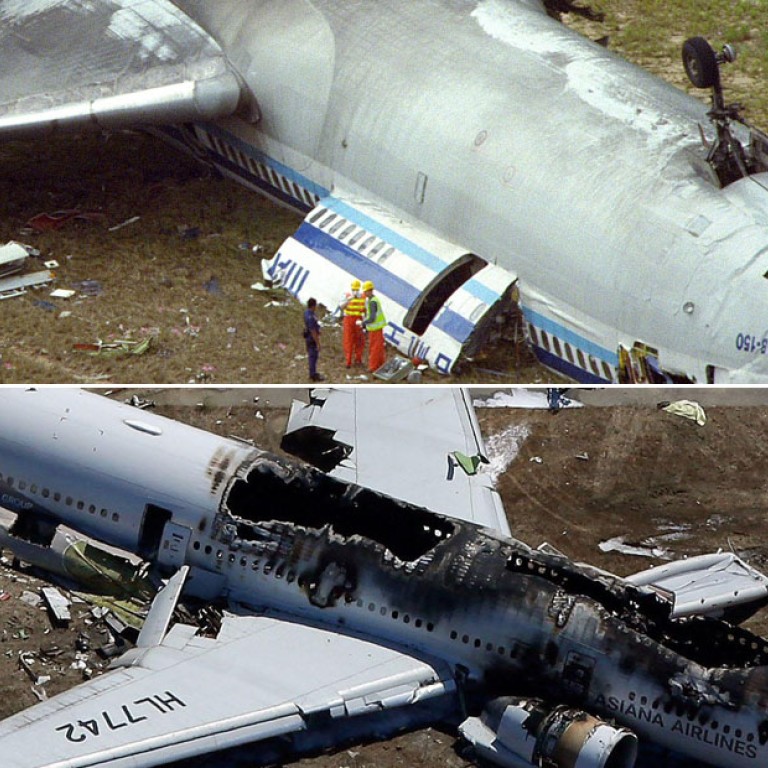
Rescuer Dave Bennett sees grim echoes of 1999 Hong Kong jet crash in Asiana accident
US images bring to mind similar crash-landing at Chek Lap Kok that reinforced a policeman's resolve to continue serving in the front line
The blackened wreckage of the recent Asiana Airlines crash-landing in the United States has brought back stark memories for people involved in an eerily similar tragedy at Chek Lap Kok airport in 1999.
For Dave Bennett, 45, images of the San Francisco crash two weeks ago took him back 14 years to the evening of August 22, 1999, when his life - and decision to become a police officer - flashed before him.
Bennett, senior inspector and head of the elite airport security unit at the time, was one of the first people on the scene when China Airlines flight 642 crash-landed in Hong Kong during typhoon conditions.
As it approached the runway, the plane's right wing dipped and scraped the ground, causing it to flip over, burst into flames and slide for several hundred metres.
"I saw pictures of the recent crash and it's a spitting image of the 1999 one, except it's not upside down," Bennett told the last week, adding that "the number of fatalities is identical, too".
The 1999 crash claimed three lives and had 312 survivors. This month's crash in the US killed three Chinese girls and 304 people lived. Investigators confirmed on Friday that one of the girls had survived the crash but died when she was hit by a fire services truck.
A 2004 report into the Hong Kong crash attributed it to pilot error, but this was disputed by the airline and the pilot.
Bennett, now police chief inspector, received the city's first bravery award in 1999 for his efforts in those first few minutes.
"I was on airside patrol with the station sergeant when we got a report that an aircraft was on fire," he recalled. "We were about 30 seconds away by car, so we rushed over and parked about 100 metres from the aircraft and literally just ran.
"It was surreal to see an aircraft engulfed in flames and upside down. As the plane had flipped over and travelled, a lot of the fuselage had been wiped away so you had people hanging upside down in the seats and their heads were very close to the ground. It was pretty freaky."
Soaked from the heavy rain but with no fire-resistant gear, Bennett and the sergeant searched the pitch-black plane for survivors as flames travelled up the belly of the aircraft towards the fuel tanks.
"It felt like forever because everything was disoriented; people were the wrong way up, people were rushing out and fire services going in. It seemed a long time but it was a matter of seconds, minutes.
"I was acutely aware of the intense heat from the fire and my main concern was it just takes one small spark and the plane could have exploded."
He helped dozens of screaming and shocked passengers escape the burning plane, including the Italian captain Gerardo Lettich, 58 at the time.
"We saw the pilots disoriented, so it was literally a case of putting them on our backs and getting them out. I piggybacked [Lettich] and just ran. He wanted to stay by the aircraft, being the captain, but I grabbed him and took him to safety."
Bennett suffered severe burns from the highly toxic aviation fuel, and at one point, he was electrocuted. "I climbed back in the fuselage when we found out a young boy was missing. My hand touched the side of the door and there was exposed cabling, so it threw me about 10 feet and stunned me for a few seconds."
That evening was a turning point for Bennett: "For me, it confirmed what path I should choose. Some people took it as a yellow card, a warning, but it had the opposite effect on me and I remained in operations."
He has since worked in witness protection and the police tactical unit and is now in charge of traffic for New Territories South. "You really have to think on your feet and you deal with all sorts of incidents," he said.
For John Findlay, former general secretary of the Aircrew Officers Association, the 1999 crash was haunting because it was captured on video by an off-duty pilot who was plane spotting in a car park near the airport.
Findlay helped the pilots in the days after the crash to ensure they were looked after. On the recent US accident, he said: "People say the US one was a miracle because so many survived, but the Hong Kong crash was even more miraculous because the weather was foul that night and the plane exploded into flames."
